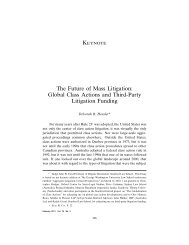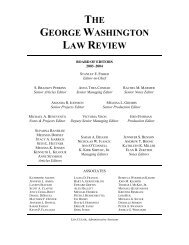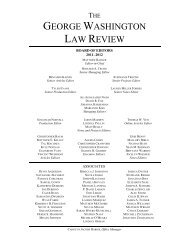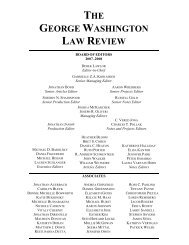View PDF - The George Washington Law Review
View PDF - The George Washington Law Review
View PDF - The George Washington Law Review
Create successful ePaper yourself
Turn your PDF publications into a flip-book with our unique Google optimized e-Paper software.
2 THE GEORGE WASHINGTON LAW REVIEWARGUENDO [Vol. 82<br />
evidence may be sufficient to support the court’s ruling.<br />
INTRODUCTION<br />
In August 2013, federal district court Judge Shira Scheindlin issued a<br />
195-page opinion in Floyd v. City of New York 1 holding unconstitutional<br />
the longstanding New York City Police Department (“NYPD”) stop-andfrisk<br />
practice used to question persons suspected of criminal activity. 2 <strong>The</strong><br />
NYPD has used that practice to implement the “Broken Windows” theory<br />
of policing first made famous by a 1982 article in <strong>The</strong> Atlantic, written by<br />
James Q. Wilson and <strong>George</strong> L. Kelling, entitled Broken Windows: <strong>The</strong><br />
Police and Neighborhood Safety. 3 <strong>The</strong> “Broken Windows” theory posits<br />
that aggressive police enforcement of low-level infractions deters wrongdoing<br />
and enhances community safety by arresting offenders on the cusp of<br />
committing a serious crime. 4<br />
In 1968, the U.S. Supreme Court in Terry v. Ohio 5 approved both the<br />
brief stop for questioning of a person suspected of criminal activity and the<br />
frisk of a stopped party reasonably believed to be armed and dangerous. 6<br />
<strong>The</strong> NYPD used that practice on more than 4.4 million occasions from January<br />
2004 to June 2012. 7 Troubled—as many people would be—by the<br />
fact that more than eighty percent of the parties stopped and frisked were<br />
African American or Hispanic, 8 Judge Scheindlin held that the NYPD practice<br />
violates the Fourth Amendment 9 and the Equal Protection Clause of the<br />
Fourteenth Amendment. 10<br />
Various parties have already weighed in on one side or the other of the<br />
court’s decision. So far, the parties have taken opposing sides in a “great<br />
taste, less filling” debate—the judge was clearly right or plainly wrong on<br />
both issues. 11 This Commentary advances a slightly different view: the<br />
1 Floyd v. City of New York, No. 08 Civ. 1034 (SAS), 2013 WL 4046209 (S.D.N.Y.<br />
Aug. 12, 2013).<br />
2 Id. at *7.<br />
3 See James Q. Wilson & <strong>George</strong> L. Kelling, Broken Windows: <strong>The</strong> Police and<br />
Neighborhood Safety, ATLANTIC, Mar. 1982, at 29.<br />
4 See id. at 31–34.<br />
5 Terry v. Ohio, 392 U.S. 1 (1968).<br />
6 Id. at 30–31.<br />
7 Floyd, 2013 WL 4046209, at *3.<br />
8 Id. at *1.<br />
9 U.S. CONST. amend. IV (“<strong>The</strong> right of the people to be secure in their persons,<br />
houses, papers, and effects, against unreasonable searches and seizures, shall not be violated<br />
. . . .”).<br />
10 U.S. CONST. amend. XIV, § 1 (“No State shall . . . deny to any person within its<br />
jurisdiction the equal protection of the laws.”).<br />
11 Compare, e.g., Terry Eastland, Don’t Stop Frisking, WKLY. STANDARD, Aug. 26,









